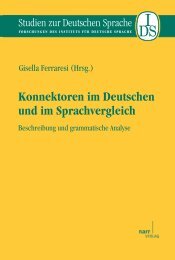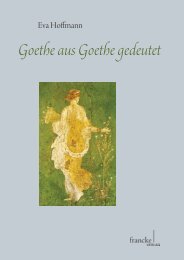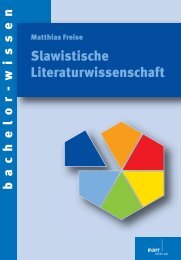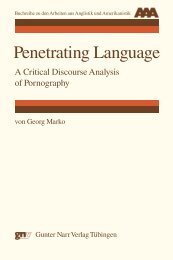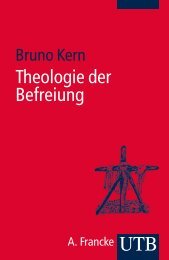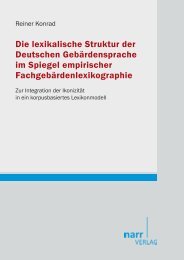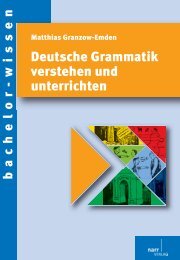Phraseologie. global - areal - regional - im Shop von Narr Francke ...
Phraseologie. global - areal - regional - im Shop von Narr Francke ...
Phraseologie. global - areal - regional - im Shop von Narr Francke ...
You also want an ePaper? Increase the reach of your titles
YUMPU automatically turns print PDFs into web optimized ePapers that Google loves.
18<br />
Elisabeth Piirainen<br />
metalanguage. As a working term, Widespread idiom (or WI for short), has been suggested. 4 Because<br />
this term is newly introduced to linguistics, we need to create a working definition. This<br />
definition must be based on criteria by which actual WIs in Europe and beyond can be singled out<br />
from other idioms that exist in some five, six or more languages. Therefore, the definition is initially<br />
based on heuristics, starting exclusively from the linguistic situation of Europe and the empirical<br />
multilingual phraseological data.<br />
As far as the linguistic situation of Europe is concerned, with its many genetically diverse languages<br />
between the Atlantic and the Ural mountain range, extra-linguistic factors are taken into<br />
account. In order to be considered “widespread”, idioms must occur in languages of the main<br />
geographic regions of Europe; this means that they are not only genetically distant but are also not<br />
neighboring geographically. By this criterion, idioms are excluded which may exist in several<br />
languages but whose circulation is restricted to only a small area (comparable to a “Sprachbund”<br />
where languages are in narrow contact with each other, be it through a diglossic situation, roofing<br />
languages or cross-border contacts). The definition will not require any particular min<strong>im</strong>um number<br />
of languages involved.<br />
Furthermore, the specific characteristics of the semantics of (prototypical) idioms are included<br />
in the definition. This refers to the interaction of the two semantic levels of an idiom: its inner<br />
form (the literal meaning) and its figurative or actual meaning. Firstly, idioms to be designated as<br />
WIs must have the same or a s<strong>im</strong>ilar lexical structure in various languages. Secondly, these idioms<br />
must have a s<strong>im</strong>ilar figurative meaning, 5 to be precise: they must share the same figurative<br />
core meaning.<br />
Such wide concepts of s<strong>im</strong>ilarity both at the level of literal readings and at the level of actual<br />
meanings leave room for an interpretation of each individual case within its historic-cultural development:<br />
We must take into account the characteristic feature of idioms as linguistic signs that<br />
are handed down historically and coined culturally. In the course of history, both the literal and<br />
the figurative meaning of an idiom of an individual language can be affected by individual developments<br />
that are unique to one language. If, therefore, lexical-semantic divergence is observed<br />
from a synchronic perspective, cultural foundations must be taken into account to clarify the question<br />
whether we are dealing with a WI or not. 6<br />
The definition is thus: Widespread idioms (WIs) are idioms that – when their particular cultural<br />
and historical development is taken into account – have the same or a s<strong>im</strong>ilar lexical structure<br />
and the same figurative core meaning in various different languages, including geographically<br />
and genetically distant languages.<br />
3 Ascertaining widespread idioms: methodological approach<br />
It is completely unpredictable which idioms are actually affected by a wide dissemination and<br />
which ones are not. There are some vague ideas that idioms originating in works of world literature,<br />
in the Bible or Greco-Roman classics, tend to exist in many languages, but nothing definite<br />
can be said which these idioms are in reality. The German phraseological lexicon, for example,<br />
has about 150 idioms of biblical origin (cf. Parad 2003), most of them being more or less wellknown<br />
and actively used by the speakers. However, no explication has been found, why “only” 43<br />
biblical idioms and further 12 idioms known both from the Bible and other texts are really spread<br />
4 Terms like Europeanism or internationalism are not appropriate for our objectives (cf. Piirainen 2008a, 244f.).<br />
5 By this criterion, cases are excluded where lexical structures that are identical s<strong>im</strong>ply by chance lead to diverging<br />
semantic results (so-called false friends).<br />
6 Therefore, the proper place of this research project is not in contrastive linguistics in the traditional sense. It cannot<br />
pr<strong>im</strong>arily be concerned with relationships of equivalence between idioms of different languages (e. g. with respect to<br />
all their diasystematic features or their syntactic, pragmatic, and/or textual behaviour).





